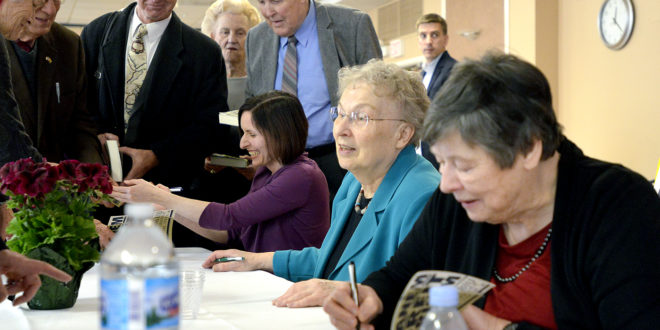Sandra Baksys.
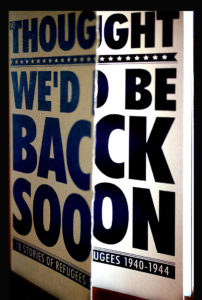
As traumatized survivors of three invasions of their homeland (Soviets in 1940, Nazis in 1941, and Soviets, again, in 1944), members of Lithuania’s “DP” generation were famously tight-lipped about their World War II refugee experiences.
Until my father Vince was in his 70s and 80s, I learned few details of his flight from the family farm near Viduklė, Lithuania, in October 1944, at age 25, with two horses, a carriage with a milk cow tied to the back–and only about half of his eight brothers and sisters.
Dad’s “oral history” was taken piecemeal by multiple daughters over many years and was never written down. As a result, we are probably lucky to have learned of Dad’s involuntary induction—along with his brothers— into a support unit of the German Army in December 1944, his winter 1945 capture by the U.S. Army, and his subsequent 16 months of starvation and hard labor as a POW under various Allied commands.
Dad’s fateful somersault, upon his release in June 1946, from abused POW to service in the U.S. Army “Home Guard,” is astounding to consider. But there are many similar twists of fate in the 18 Lithuanian oral histories that comprise this collection selected and edited by Dalia Stake Anysas, Dalia Cidzikaite, and Laima Petrauskas Vanderstoep.
Each of these recorded and edited interviews benefits from standard questions deliberately selected for their historical relevance. Likewise, the book’s formal oral history approach draws out emotion and detail that otherwise might never fully emerge from the natural chaos of conversation. The interviewers’ interjections and follow-up questions, plus careful editing, add even more critical value by helping to sustain a narrative line that might easily have been lost in conversation’s tendency to digress.
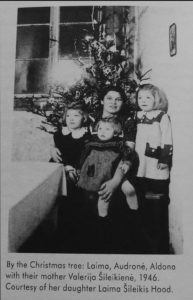 A Tapestry of Refugee Experience
A Tapestry of Refugee Experience
Taken in the mid-to-late 1990s, some 50 years after the events being remembered, these personal histories provide a tapestry of war-time experiences disparate in their details. Yet, more than a few of the stories are so richly detailed that they stand as microcosms of the whole.
In features common to many, fleeing men are separated from their families and forced to dig foxholes under Soviet artillery fire, much as cars and farm animals have previously been requisitioned for the German war effort. (The struggle of Lithuanian civilians to remain non-combatants begins with Lithuanian resistance to the formation of an SS unit, to which the Nazi occupation authority responds by closing Lithuanian universities.)
Everywhere on the refugee road are Lithuanian women fleeing with small children, sometimes giving birth in open wagons in the cold and rain. As well, there is the unique vulnerability of minors wandering World War II’s killing fields without parental guidance or protection.
More than anything, we experience the refugees’ constant struggle with hunger and exposure to the elements, plus the difficulty of transit further and further west as the Soviet Army advances.
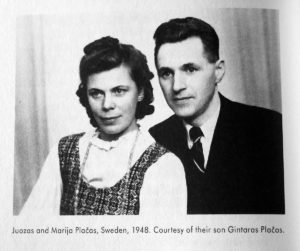 ‘Why Did You Leave?’
‘Why Did You Leave?’
One of the biggest historical questions the interviewers set out to nail down for posterity was, “Why did you leave?” Almost unanimously, the refugees in this collection—from urban academics, teachers and public officials to remote villagers and farmers—say they had been slated for a second round of mass deportations to Siberia that the Soviets did not have time to implement before being driven out of Lithuania by the German Army in June 1941. (Soviet deportation lists became public during the subsequent German occupation.)
The atrocity-level treatment of those 1941 deportees, combined with the brutal NKVD torture and murder of Lithuanian detainees in places like Rainiai Forest, sowed a lasting terror among tens of thousands more so-called “enemies of the state” who could expect similar treatment upon the Russians’ return in 1944.
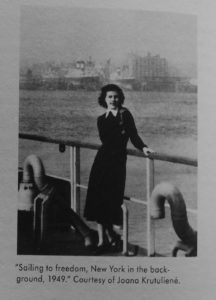 Inextricably tied to this “why” is the question of how long the refugees expected to be gone. As it turns out, none of the young refugees who ended up exiled for the rest of their lives expected, when they fled, to be gone more than a few months.
Inextricably tied to this “why” is the question of how long the refugees expected to be gone. As it turns out, none of the young refugees who ended up exiled for the rest of their lives expected, when they fled, to be gone more than a few months.
Over and over, the reader’s sense is that the decision to leave in its full scope and finality was never actually made. For most of the subjects, flight was a series of immediate crisis survival steps without am overarching plan.
‘Who Could Have Known?’
At the same time, Russia’s military alliance with the Western powers, as well as the presence of U.S. troops in Germany, implied to the mass of Lithuanian refugees fleeing in summer and autumn 1944 a degree of Western influence over Russia sufficient to restore Lithuanian independence at war’s end and a quick return home.
To return, the refugees needed Lithuania’s borders to return, which unfortunately, didn’t happen for another 50 years. Confidence in Western influence over the situation first began to erode as early as spring 1945 when the “DPs” witnessed Soviet soldiers crossing freely from the Russian zone into the British, French, and American occupation zones where the refugees had taken shelter.
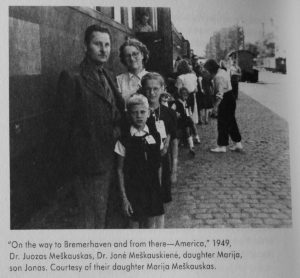 To the refugees’ chagrin, Soviet political commissars also were allowed freely to roam the displaced persons (“DP”) camps, arguing and cajoling for the frightened émigrés’ return. Initially, according to these witnesses, some Russians, Balts, and Byelorussians were forcibly transported to the Soviet zone.
To the refugees’ chagrin, Soviet political commissars also were allowed freely to roam the displaced persons (“DP”) camps, arguing and cajoling for the frightened émigrés’ return. Initially, according to these witnesses, some Russians, Balts, and Byelorussians were forcibly transported to the Soviet zone.
According to Adolfas Damušis, a lifesaving “no forced repatriation policy” was obtained with the help of Lithuanians—perhaps exiled officials of the VLIK–working within UNRRA, the United Nations Relief and Rehabilitation Administration that operated the camps.
Bronė Urbonienė relates how some Yugoslav and Ukrainian “DPs” decided to fight back, attacking, overturning, and burning the jeep of Russian political commissars entering their camp to “register” refugees for repatriation. “In the jeep’s trunk, they (the frightened and enraged “DPs”) found all kinds of photographs and lists of us all, the refugees there. And that happened…in the American zone in Munich…There (must have been) people among us who worked for them (the Soviets).
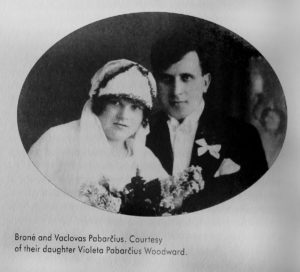 What They Left Behind, and Why
What They Left Behind, and Why
Within the context of the short-term absence the refugees anticipated, educator Jonas Kavaliūnas explains that sick family members—even minor children—were left behind on extended family members’ farms. In the short-term, it was assumed the physically weak would be better off with plenty to eat than on a trek into the wartime unknown.
Other evidence of the “DP” expectation of a quick return is found in the universal practice of burying valuables on the homestead for subsequent retrieval—everything from china dishes to store-bought Sunday clothes. This reflected a fear of theft not just by local opportunists, but also the same “beggarly” Soviet Army that had invaded, occupied, and looted Lithuania 1940-41.
The burial of one family’s supply of lard near Šiauliai (flour, bacon and lard turn out to be life-saving provisions) is indicative of yet another phenomenon. For many refugees, far more than any global decision to abandon the homeland, retreat was a spontaneous series of stops, starts, and off-loadings of possessions that reflected the advance of the Soviet Army and the hope that leaving Lithuania altogether could be avoided.
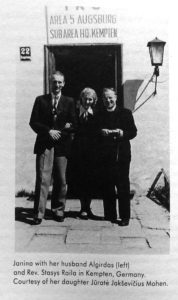 Only that final spasm of retreat across Lithuania’s western border in horse-drawn wagon or on foot invokes such classic gestures of exile as stopping to scoop up a handful of earth. Old people reportedly ask to be awakened as they cross the border so they can catch one last glimpse of the homeland.
Only that final spasm of retreat across Lithuania’s western border in horse-drawn wagon or on foot invokes such classic gestures of exile as stopping to scoop up a handful of earth. Old people reportedly ask to be awakened as they cross the border so they can catch one last glimpse of the homeland.
Falling Back with Germans —or Nazis?
As a fractal of the bigger “Why leave Lithuania” question, the modern American reader might wonder why Lithuanians were falling back on the same roads, trains, and ships as Nazi forces. The answers given here are not always explicit because the dilemma of being caught between Stalin and Hitler without any third option was, to the refugees, completely self-evident.
Bookkeeper Brone Parbaciene, whose husband has been tortured and mutilated to death by the NKVD at Rainiai Forest, lays it out straight: “I had already suffered at the hands of the Russians, so I fled to the other side, which took us in.”
Valerija Šileikienė explains, “We thought: two devils–one’s brown and the other’s red. Let’s choose the brown devil.” Nevertheless, as refugee families flee deeper into “German lands,” their life-and-death need for shelter and work-linked food ration cards—as well as transit papers to reunite with their involuntary inducted husbands–makes them more and more dependent on German authorities and individuals. Because of this dependence, it is impossible for either the refugee or the reader to see Lithuanians’ German hosts as uniformly evil.
A Range of German Experiences
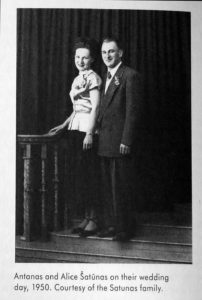 We have callous Nazi-loving estate owners who force Lithuanians to work for insufficient food and sleep with their children in filthy pigsties. We have soldiers who shoot hungry refugees whose only crime was to enter abandoned Konigsberg / Karaliaučius homes from which Germans have fled. But we also have small German farmers, soldiers, bureaucrats, and midwives who help to feed, clothe, and shelter a flood of anti-Soviet refugees amid the shared hardships of war.
We have callous Nazi-loving estate owners who force Lithuanians to work for insufficient food and sleep with their children in filthy pigsties. We have soldiers who shoot hungry refugees whose only crime was to enter abandoned Konigsberg / Karaliaučius homes from which Germans have fled. But we also have small German farmers, soldiers, bureaucrats, and midwives who help to feed, clothe, and shelter a flood of anti-Soviet refugees amid the shared hardships of war.
One Lithuanian mother gratefully remembers how her toddler received an egg every day, despite German food shortages. Another mother is efficiently delivered of her placenta, post-childbirth on the open road, by a German Army doctor in retreat who refuses any payment. German police who initially insist penniless refugees pay their own train fares to an interrogation point proceed to lend them the cash to do so—which the refugees conscientiously repay after finding work.
The Advantages of Language
Over and again, German culture and language proficiency permits Lithuanian professionals and intellectuals to bargain for what they need from harried authorities and locate and take refuge with friends and relatives already living in “German lands” (meaning Karaliaučius and occupied Poland as well as Germany, itself).
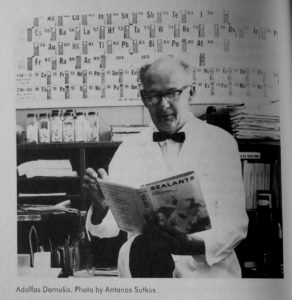 However, the helpful German connections possessed by Lithuanian academics and professionals who trained in German institutions or worked in interwar German-owned businesses were lacking among rural Lithuanian refugees—with negative results. For example, not understanding German, perhaps my farmer father and his brothers didn’t even know they were being inducted until they were spirited by train to Innsbruck, Austria, in December 1944 for basic training.
However, the helpful German connections possessed by Lithuanian academics and professionals who trained in German institutions or worked in interwar German-owned businesses were lacking among rural Lithuanian refugees—with negative results. For example, not understanding German, perhaps my farmer father and his brothers didn’t even know they were being inducted until they were spirited by train to Innsbruck, Austria, in December 1944 for basic training.
Not knowing the language, and without any skills critical to war-time civilian life, Dad and his brothers certainly lacked any bargaining chips at a time when Germany’s military needs were desperate. One of my aunts was even put to work in a German anti-aircraft battery. Lithuanian doctors like Juozas Meškauskas and Janina Jakševičienė, meanwhile, were immediately assigned to understaffed civilian hospitals and clinics.
Farmers’ Unique Trauma
Subsistence Lithuanian farmers experienced many other unique traumas in their flight from homesteads whose improvement had been the work of their entire lives—the land and its cycles, their entire world. For these rural refugees, the reality of all they were leaving hit hardest when being relieved of their horses and wagons after crossing Lithuania’s western border. (Milk cows often had been abandoned on the road because they couldn’t keep pace with wagons).
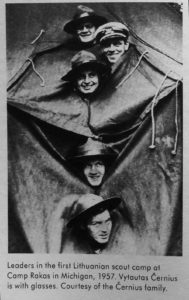 Farmer Juozas Taoras tells how he and his wife go to see the horses they were forced to sell the day before to the German Army:
Farmer Juozas Taoras tells how he and his wife go to see the horses they were forced to sell the day before to the German Army:
“(At first) when we fled, we weren’t sorry for anything, just to get away faster,” he recalls. But as the couple approaches their horses, the animals recognize them. Having gone unfed and tied to a rail all day and night, the animals begin neighing and pawing expectantly, hoping their longtime owners will feed and water them.
Helplessly, Taoras recalls, “We came up and stroked them…and both my wife and I began to cry because they had pulled so faithfully, they had pulled so much that they were now skin and bones.”
The couple’s loss in this moment goes beyond the transportation they still need but have lost—even beyond humane concerns. What they feel is “an abandonment” at the stripping away of their “last asset” — abandonment, with no last vestige of their former lives and selves.
History in the Human Voice
By its accumulation of such detail, We Thought We’d Be Back Soon enhances anything the reader may already have believed or known about the flight of the Lithuanian “DP” generation. Almost without effort, “DP” descendants will find gaps in their own family stories filled.
It’s as if a veil between the generations has been lifted, and we can suddenly see our parents or grandparents as they were when they were young during a desperate time in a different world. We are there. And certain images and anecdotes, different for each reader, will linger long after the reading is finished.
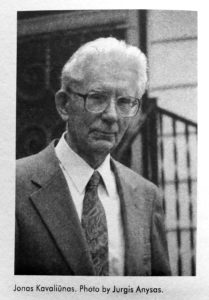 On the humorous side, we have an invading Nazi column that stops on the outskirts of a Lithuanian town in June 1941 so the soldiers can shine their shoes and shave before presenting themselves as occupiers.
On the humorous side, we have an invading Nazi column that stops on the outskirts of a Lithuanian town in June 1941 so the soldiers can shine their shoes and shave before presenting themselves as occupiers.
For the heart-wrenching, we have the story of a Lithuanian refugee infant born into such hunger and want that she dies on a train passing through Berlin in late 1944 and is buried by German strangers in between bombardments.
Then, there is the Lithuanian railroad manager who refuses passage on one of the last departing overcrowded trains to the wife and children of his own Soviet-deported and executed co-worker–while filling two rail cars with his personal possessions.
Again, we have the farmer Taoras, who in 1945 is forced to flee arrest and his first good job with servicemen in the American occupation zone simply because he has dared to equate Stalin with Hitler.
Personally, I can’t forget the brave grocery shop girl who’s exiled to Siberia in 1941 after she dares tell the wives of two occupying Russian officers not to butt in line because there was plenty of food in Lithuania before the Soviets emptied store shelves.
And there is one unforgettable anecdote about the Red Army’s campaign of rape in conquered Germany. In it, a desperate Lithuanian “DP” mother protects herself and two young girls by screaming in broken Russian that she is not German but Lithuanian–and can’t wait to go home now that Lithuania is Soviet-”liberated.” Her desperate bluff works because it flatters the soldiers’ view of themselves as benign liberators even in the act of rape.
Little Lithuania in the Displaced Persons Camps
Almost every refugee in this book recounts the dramatic flowering of Lithuanian culture and education–including schools, drama troupes and choirs–as soon as the refugees sort themselves into their own national groups within the system of post-war “displaced persons” camps. What is truly remarkable is that these feats of national and cultural assertiveness occurred literally as soon as the camps were organized.
Lithuanian elementary and high schools and Lithuanian Scouts with hand-sewn uniforms were already appearing the same month that the war in Europe ended, in barracks where food was still scarce and shelter primitive. What could this be except Lithuania re-created by refugees united in a communal yearning to return home soon?
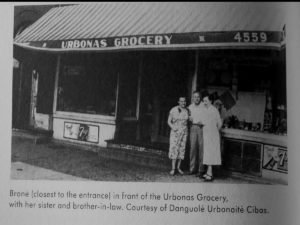 Certainly, Germany was not home, but the refugee camps there were an immediate collection point for those only recently exiled: the closest spot in time and space to home, where atomized individuals could reunite in a major expression of communal desire.
Certainly, Germany was not home, but the refugee camps there were an immediate collection point for those only recently exiled: the closest spot in time and space to home, where atomized individuals could reunite in a major expression of communal desire.
Of course, it helped that so many of the exiles were leading Lithuanian academics, educators, and cultural figures. One can imagine them living and organizing by their wits in a place where they are not entitled to anything but the most basic sustenance–and almost everything has been consumed by war.
Yet educator Kavaliūnas tells us that a Lithuanian school already had been organized by May 10, 1945, in the Freiburg camp(s), and the same month, in Tübingen. He details the printing of one of the first Lithuanian grammar texts in Stuttgart in December 1945—as well as the difficulty of obtaining paper, ink, and a functional printing press for the job. “The idea (of organizing schools in the camps, where hunger was a daily experience), was that returning to Lithuania in a short time, our children wouldn’t have lost a year (of schooling).”
Joana Krutulienė recalls, “All of that activity was so vibrant, people were exceptionally creative. Having nothing, really, they were capable of doing, working, acting in concert… establishing schools… The artistic ensembles (choirs and drama groups) made us feel alive, united us in some way… Such a vital life, such a desire to survive, to be active.”
Conflicted Views of the First Wave
It is also in the camps where many “DPs” have their first encounters with Lithuanian-Americans of, or descended from, ‘first wave’ immigration to the U.S. between 1880 and 1914. Most of these helpful interventions by Lithuanian-American priests, Army translators, and common soldiers on the ground in postwar Germany are mentioned only in passing—perhaps due to the condensed formats of these stories.
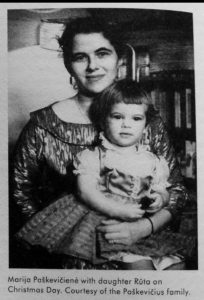 Rather more is said by many of the same “DPs,” once in the United States, about “first-wavers” from a more primitive Lithuania who don’t understand them or their more advanced Lithuania. On another note, Taoras tells of “a good-hearted man of the old emigration” who helps him advance at work in Chicago–to the point where all the other “first-wavers” on the job are jealous of him.
Rather more is said by many of the same “DPs,” once in the United States, about “first-wavers” from a more primitive Lithuania who don’t understand them or their more advanced Lithuania. On another note, Taoras tells of “a good-hearted man of the old emigration” who helps him advance at work in Chicago–to the point where all the other “first-wavers” on the job are jealous of him.
Yet almost every refugee in this collection ultimately is sponsored by a member or descendant of the Lithuanian “first wave” under the U.S. Displaced Persons Act of 1948, from which the shorthand “DP” derives. Krutuliene sums it up best when she says, “I appreciate (those) Lithuanians…so much because …their heritage had survived…When we got here, there was already something for us: there were parishes already, churches already.”
Despite their uneasy relationships, “DP” (“second wave”) immigrants do, indeed, build on the institutions of the first immigrants. Their tremendous achievements in creating dozens of new “heritage” schools, choirs, dance ensembles, Scout troops and summer camps are firmly anchored in decades-old Lithuanian-American parishes. And it’s from these Catholic parishes in places of much older Lithuanian settlement, like Chicago, that the new immigrants promote the interwar spirit of the newly independent Lithuania cut short by the 1940 Soviet invasion—cut short in their own lives by forced emigration.
Starting Over in America
The first great flowering of Lithuanian national identity in the postwar “DP” camps (later echoed around the world) ended with the dismantling of the camps in the late 1940s. It was time for those who had united in creative, communal striving to re-start their lives on their own again from nothing but hard work—in places much farther-flung and more foreign than Germany.
In fact, as I watched the subjects in this book facing the end of the national revival they had created in the camps, it seemed to me the beginning of a second, even sadder diaspora.
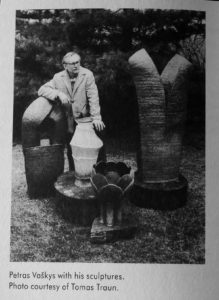 Certainly, the late 1940s campaign of resettlement from post-war Germany was preferable to any forced return to the Soviet-occupied homeland. However, in the short term, “DP” resettlement tore apart people who were coping with the daily dashing of their hopes to return home soon by living together in a substitute “national” community. And rather than helping them preserve even the fragile solace of community, it instead dispersed them around the world.
Certainly, the late 1940s campaign of resettlement from post-war Germany was preferable to any forced return to the Soviet-occupied homeland. However, in the short term, “DP” resettlement tore apart people who were coping with the daily dashing of their hopes to return home soon by living together in a substitute “national” community. And rather than helping them preserve even the fragile solace of community, it instead dispersed them around the world.
In resettlement, the “DPs” were buffeted by powerful centrifugal forces, not just globally in diaspora across multiple host nations, but also locally in search of work, career, and affordable housing. With no equivalent to their immediate, on-the-ground national “collection point” in the camps of postwar Germany, refugees dispersed to the U.S., Canada, Australia, Great Britain, and South America were required to find or create their own new “collection points.”
Again, “first-wave” settlement played a critical role—reuniting “DPs” in cities like Chicago where their immigration sponsors were clustered. Soon, Chicago, Cleveland, Detroit, and Toronto were pulling away “DPs” from more remote places of resettlement with their enhanced opportunities for living a “Lithuanian life.”
The chance to re-form their lost community in places of earlier Lithuanian settlement did not solve all the “DP’s” immediate problems. But it did provide an immediate base for receiving and organizing crucial self-help.
The survival demands of physically taxing blue-collar work, further education and training in night school, and raising children remained major drains on the new immigrants’ time and energy for decades. Yet because their parting with Lithuania had been conditional, driven by survival, with the intent to “be back soon,” those who otherwise would have lived out their lives happily in a free Lithuania were soon re-creating “Little Lithuanias” all over the world.
Lithuania’s ‘Greatest Generation’
I don’t know if this makes the “DPs” Lithuania’s “Greatest Generation” alongside tens of thousands of their peers who stayed behind and died fighting the Soviets as partisans. But I fully understand the impulse to consider them such because of their enduring devotion to the survival of a free Lithuania and their many sacrifices in that cause. Even in their later years, after decades of hard work and struggle in the U.S., the Lithuanians in this collection—just like my retired factory worker father–are still dedicated to helping their beloved homeland.
Despite her personal losses and drastic uprooting as a young woman, Krutuliene muses, “It’s good that a part of us is here in immigration” because of the ability to financially support relatives back home–and from 1948-1991 to agitate for independence in ways impossible inside the U.S.S.R.
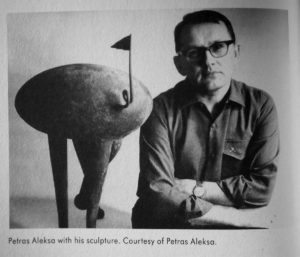 Petras Aleksa recalls, “My idea (after immigrating) wasn’t to have a job or money—it was important to make my own contribution to Lithuania.”
Petras Aleksa recalls, “My idea (after immigrating) wasn’t to have a job or money—it was important to make my own contribution to Lithuania.”
Damusis, a chemist on the verge of giving his homeland a cement industry at the time it lost independence, describes how advancing Lithuania through one’s highest educational and professional potential “was a rallying cry, and not just for me…Everyone (in the “DP” generation), no matter what they did, made something good of it (for Lithuania.) Twenty-two years of independence provided the impetus for this.”
Kavaliunas, the lifelong educator, concludes, “20 years of independence (1918-1940) imparted (so much) to Lithuanians, instilling in them the love of country—this was the huge capital that they brought with them from Lithuania.”
First published in Lithuanian in 2014, We Thought We’d Be Back Soon became available in English in 2017–just in time for the 2018 centennial of the restored Lithuanian independence that began in 1918 and lasted until the Soviet invasion of 1940.
There could hardly be a better time to hear the voices of that interwar generation forged in the heady patriotism, passion for education, and service to country that Lithuania’s first independence in hundreds of years inspired.
So many lives inspired by one great idea… So many lives that tragically could have been cut short, but in which, despite such long and traumatic displacement, a profound patriotism endured.
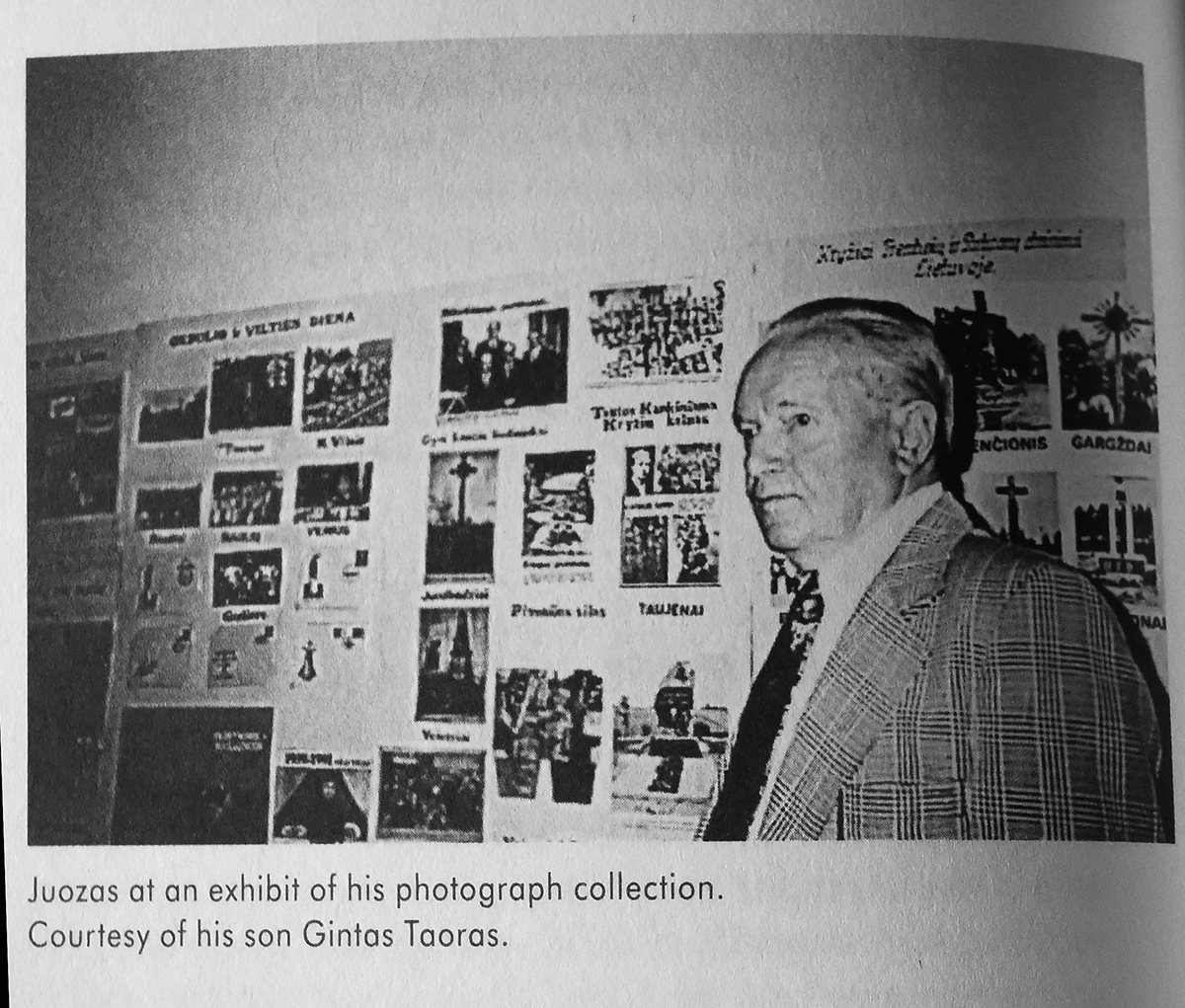
 DRAUGAS NEWS Lithuanian World Wide News in English
DRAUGAS NEWS Lithuanian World Wide News in English
